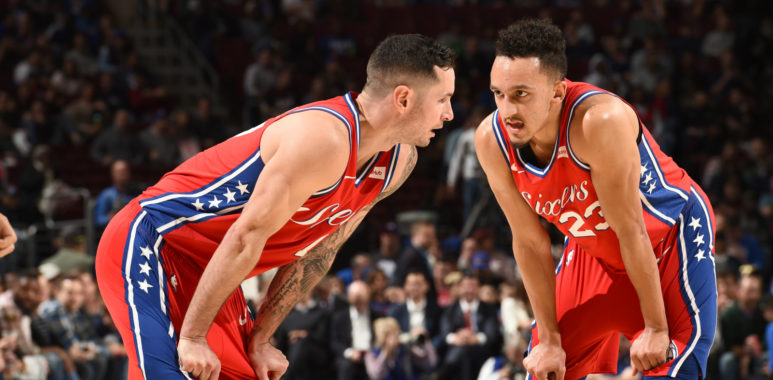
Sixers find reliability in two juxtaposed shooters
With the Sixers’ struggles at the forefront, the hot start for J.J. Redick and Landry Shamet is being overlooked
Shooting. A concept that seems too obvious for the NBA to have taken over three decades since the NBA finally rolled the three-point line in 1979 that teams would start to build around shooters. It wasn’t until Steph Curry and the Golden State Warriors absolutely destroyed the fundamental thinking of “closer shots are better shots” did we see three-pointers at such the insane rate that we’re accustomed to now. The rest of the league scrambled to play catch up, but the Sixers were in the middle of a league-changing stage of their own – The Process.
The Sixers went a completely different route than the rest of the NBA, utilizing top draft assets on three centers, a rare 6’9 point guard with no semblance of a shot, and a guard who had one of the strangest start to his career that a top prospect has ever seen, causing him to completely lose his shooting ability. It’s safe to say the Sixers have problems, after a slow start early in the season, it’s apparent that the lack of spacing between Ben Simmons and Markelle Fultz is taking a major toll on the offense’s effectiveness. Lineups with Fultz and Simmons are shooting just 21.4 percent from three, and just 39.7 percent from the field, amassing just a 91.0 ORTG.
Philadelphia still has bright spots through this sluggish start, and two of them are shooters at opposite ends of their careers. When the Sixers inked J.J. Redick to a one-year, $23 million deal in the summer of 2017, it was known he’d be at the least an impactful short-term signing. Redick is arguably the most high-profile signing since the team signed now-GM Elton Brand a decade ago.
His ability to space the floor around Simmons and Embiid, as well as score at will on transition pull-up threes, was felt immediately. Redick not only had the second-highest field goal percentage on pull-up and catch-and-shoot jumpers in the league last season, he also was a big reason why the Sixers secured one of the best five men lineups in the league last season with a +21.4 net rating, according to NBA.com/stats.
Redick, in his age 34 season, is already third in the NBA in three-pointers made as of November 5th, and is looking to repeat a scorching season. This season, however, he has a promising young shooter under his wing. Landry Shamet has made an immediate impact for Philadelphia, providing an outside scoring punch that is meant to mimic the same effectiveness Redick brings to the floor.
Shamet thus far is shooting 35.6 percent from the outside in similar flare sets as his veteran mentor utilizes so well. The rookie is currently in the 89th percentile for POE early on, and is looking like he could be a permanent replacement when Redick calls it quits for the Sixers. Before he can get to that level, however, there are some key changes needed to be made beyond the first season.
What makes Redick so unique is his ability to quickly get off difficult jump shots in both transition and in congested half-court sets. He has an incomparable ability to find open space off the ball, then rise up and get enough trajectory to shoot over bigger defenders. It’s a craft that he perfected over his long career, and one that Shamet must hone in on to make a big instant leap.
The ball trajectory and position of the shot pocket is the key when assessing Redick and Shamet. The clear difference between seasoned shooter and unpolished rookie comes into play here. Watch Redick in the clip above release the ball high above his head to allow for a perfect trajectory that allows for a higher percentage of the shot falling. Now, watch the clips of Shamet below and notice the difference in angle and how the ball falls towards the hoop.
The release point in both shots is lower compared to Redick’s, causing an almost flat trajectory to the bucket. This not only makes it difficult for Shamet to shoot over larger defenders, but it lowers his make probability and can cause long defensive rebounds that spark transition buckets. These are the little quirks in the formula of shot making that can elevate Shamet’s productivity.
Shamet is stepping into a big bench role right off the bat, and maybe the minutes start to dip for him with the return of wing Wilson Chandler, but Brett Brown’s eyes should be lit up watching the young shooter start to get comfortable so soon. With the expectation of Redick to provide a majority of the outside shooting, Brown can now turn to two deadeye shooters off the pine to score effectively.
The Sixers are still trying to find momentum within their starting core, but with all the talk of spacing restrictions and the loss of two bench players last season, Philadelphia is sitting on the inklings of a cohesive team that can finally move to a dangerously dynamic offense in the second unit. Redick and Shamet have been bright spots for a team still trying to find their bearings. A bright spot whose light never seems to dim, and another bright spot who is looking to shine brighter. The importance of shooting to this offense is evident, and the Sixers have a bench duet that can shoot with starting-level firepower.
Photo by David Dow/NBAE via Getty Images
